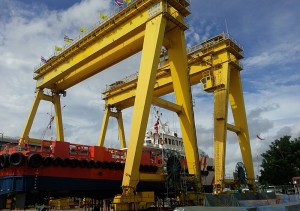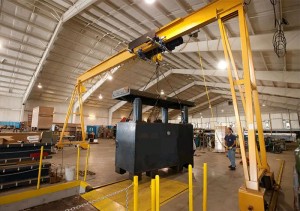
Easy Operation Railroad Gantry Crane Support Product
Product Details and Features
Rail-mounted design: The crane is mounted on rails or tracks, allowing it to move horizontally along the length of the rail yard or terminal. This feature enables the crane to cover a large area and access multiple tracks or loading bays.
Lifting capacity: Railroad gantry cranes are built to handle heavy loads. They typically have a lifting capacity ranging from 30 to 150 tons or more, depending on the specific model and application requirements.
Span and outreach: The crane’s span refers to the distance between the crane’s legs or support structure. It determines the maximum width of the rail tracks the crane can cover. The outreach refers to the horizontal distance the crane’s trolley can reach beyond the rail tracks. These dimensions vary based on the crane’s design and intended application.
Lifting height: The crane is designed to lift cargo to a specific height. The lifting height can be customized based on the application and requirements of the rail yard or terminal.
Hoisting mechanism: A gantry crane typically employs a hoisting mechanism consisting of wire ropes or chains, a winch, and a hook or lifting attachment. The hoisting mechanism enables the crane to lift and lower cargo with precision and control.
Application
Loading and unloading containers: One of the primary uses of railroad gantry cranes is for loading and unloading shipping containers from trains onto trucks or vice versa. These cranes have the capacity to lift heavy containers and position them accurately for transfer between different modes of transportation.
Intermodal facility operations: Gantry cranes play a crucial role in intermodal facilities where cargo needs to be transferred between railcars, trucks, and storage areas. They facilitate the efficient movement of containers, trailers, and other freight within the terminal, ensuring smooth operations and minimizing handling time.
Freight handling: Railroad gantry cranes are employed for general freight handling in rail yards. They can lift heavy and bulky items such as machinery, equipment, and large palletized goods. These cranes are used to load and unload freight cars, rearrange cargo within the yard, and position items for storage or onward transportation.
Maintenance and repair: Gantry cranes are also utilized for maintenance and repair operations in rail yards. They can lift locomotive engines, railcars, or other heavy components, allowing for inspections, repairs, and component replacements. These cranes provide the necessary lifting capacity and flexibility to handle various maintenance tasks efficiently.







Product Process
Access to components: Gantry cranes are large and complex machines, and accessing certain components for maintenance or repair can be challenging. The height and configuration of the crane may require specialized equipment or access platforms to reach critical areas. Limited access can increase the time and effort required for maintenance tasks.
Safety considerations: Maintenance and repair activities on gantry cranes involve working at heights and around heavy machinery. Ensuring the safety of personnel is of utmost importance. Strict safety protocols, including the use of fall protection systems, lockout/tagout procedures, and proper training, are essential to mitigate the risks associated with working on gantry cranes.
Heavy lifting requirements: Gantry cranes are designed to lift heavy loads, which means maintenance and repair tasks may involve handling large and cumbersome components. Proper lifting equipment, such as hoists or auxiliary cranes, may be required to safely remove and replace heavy parts during maintenance operations.
Specialized knowledge and skills: Gantry cranes are complex machines that require specialized knowledge and skills for maintenance and repair. Technicians working on these cranes need to have expertise in mechanical, electrical, and hydraulic systems. Keeping the workforce trained and up to date with the latest technologies and maintenance practices can be a challenge.
















